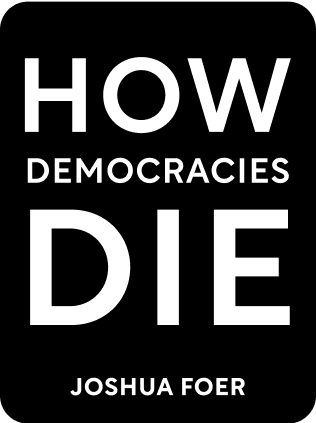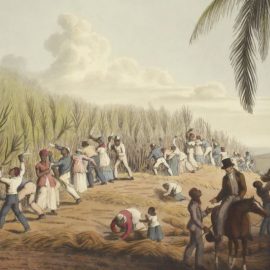

This article is an excerpt from the Shortform book guide to "How Democracies Die" by Steven Levitsky and Daniel Ziblatt. Shortform has the world's best summaries and analyses of books you should be reading.
Like this article? Sign up for a free trial here .
What is the book How Democracies Die about? How does it explain democratic principles and how to preserve them?
The book How Democracies Die explains how authoritarians come to power, and the terrifying path the U.S. is on. But it also explains how we can save our country from authoritarianism and save democracy.
Read more about the book How Democracies Die and what it says about the future of the U.S.
How Democracies Die: Major Book Themes and Sections
The election of Donald Trump has sparked a great deal of discussion about the fate of American democracy. Does the election of a figure like Donald Trump—an inexperienced outsider with obvious authoritarian instincts—suggest that democracy in the US is backsliding? Are we doomed to suffer the fate of other 21st-century democracies, like Hungary, Venezuela, and Turkey, where true democracy ceased to exist? By what processes was democracy killed in those and other countries, and how might we prevent it here?
These are the questions that How Democracies Die seeks to answer. Authors and Harvard University political scientists Steven Levitsky and Daniel Ziblatt explore the historical processes by which democracies came to extinction in other countries in the 20th and 21st centuries, while examining the rise of anti-democratic forces in American politics during the same time period.
By identifying the specific tactics that autocrats employ in their efforts to dismantle representative government and outlining the political conditions that give rise to authoritarian movements, Levitsky and Ziblatt’s work serves as a warning for imperiled democracies—and a blueprint for how to save them.
Signs of Authoritarians According to How Democracies Die
To prevent authoritarians from taking power and begin dismantling democracy, it is important to be able to identify them first. There are four warning signs of authoritarians. Such politicians:
- Reject the generally accepted rules of democratic competition, often by refusing to accept the results of democratic elections if they are unfavorable to them or their movement.
- Refuse to accept the legitimacy of their democratic opponents, accusing them of being traitors or criminals.
- Endorse or encourage violence by their political supporters against their political opponents.
- Express a willingness to crack down on civil liberties, especially those of their political opponents.
The Gatekeeping Role of Political Parties
Mainstream political parties act as democracy’s gatekeepers, helping to keep authoritarians who exhibit these traits from attaining power. There are four main strategies that political parties use to act as gatekeepers:
- Refusing to nominate extremists for office and disavowing them even if they somehow manage to win a party nomination.
- Getting rid of extremists within the party, even if doing so entails paying a short-term political price.
- Refusing to forge alliances or enter coalitions with anti-democratic parties.
- Working with one’s traditional opponents to form a united front for democracy.
Party Insiders in American Politics
Political parties long played the same role in American politics, blocking potential extremists and authoritarian populists from attaining power. Traditionally, party insiders selected presidential nominees from a roster of well-known politicians.
This crucial gatekeeping function is why political outsiders with no connection to parties fared poorly throughout most of American history. We can see this in the failed candidacy of segregationist Alabama Governor George Wallace. Considered unacceptable and unelectable by the leadership of both major parties, Wallace was forced to mount a third-party bid for the presidency in 1968 under the American Independent Party banner. Given America’s two-party system and the winner-take-all nature of the Electoral College, this doomed his longshot presidential bid to failure.
Weaknesses of the New System and the Rise of Trump
The new system rendered the parties vulnerable to hostile takeovers by outsiders with little institutional support within the party. They were especially vulnerable to outsiders who had the right combination of pre-existing fame and money—in other words, celebrities.
In 2015, Donald Trump launched his bid for the Republican nomination. The new system gave a famous, media-savvy, and wealthy outsider like Trump a decisive advantage and proved once and for all that the old system of party gatekeeping was truly gone.
Although Trump failed to win major endorsements from establishment Republican figures or contributions from mega-donors, his ability to generate free media coverage through his outlandish and extreme public statements and his popularity with influential figures in right-wing media proved to be far more powerful weapons. He caught on with the Republican base, and GOP leaders found that they had no formal mechanisms to block his nomination once he won enough delegates to become the presumptive nominee.
The GOP, however, failed the most crucial test of its gatekeeping role as a responsible political party when they chose to stand by him in the general election against Democratic nominee Hillary Clinton. Republican leaders were unwilling to pay the short-term political price that responsible democratic gatekeeping often entails. They chose party over country and party over democracy in 2016.
How Democracies Die Explains The Tools of Authoritarianism
Once they are in power, authoritarians use three main tactics to dismantle democracy:
- Capturing the referees
- Sidelining their opponents
- Changing the rules of democratic competition
These changes may all technically be within the bounds of the law, but they all represent grave threats to a free democratic system. As we’ll explore later, the Trump administration has attempted to use all of these tactics since coming to power in 2017, with varying degrees of success and pushback. Let’s look at how they’re applied generally.
The Power of Norms
Countries avoid succumbing to authoritarian parties through strong democratic norms. Norms are the unwritten rules that govern political conduct. They are guardrails that prevent political competition from getting too intense or the stakes of elections from getting too high, thus turning every election contest into a winner-take-all battle that justifies winning at any cost. There are two norms that deserve special consideration—mutual toleration and institutional forbearance.
Mutual toleration is the idea that one’s opponents have a right to govern, as long as they win fair elections and agree to play by the system’s written and unwritten rules. Fundamentally, it means treating competitors as rivals, not enemies.
Institutional forbearance is the unwritten rule that political actors will not weaponize their control of institutions to marginalize opponents or hamper effective day-to-day democratic governance—even if such behavior is technically allowed under the constitution.
Constitutional hardball is what results when politicians abandon restraint and abuse their institutional prerogatives to maximize their advantage over their opponents. Thus, a congress might start routinely blocking the president from appointing members of the cabinet; an executive might routinely issue executive orders that bypass the legislative branch; and a supreme court might declare all laws passed by the opposition as unconstitutional.
The Era of Polarization
For much of the 20th century, both major parties were big-tent coalitions, with their support cutting across religious, ethnic, geographic, and ideological lines. This arrangement began to unravel as a result of the success of the civil rights movement. Major pieces of legislation like the Civil Rights Act of 1964 and the Voting Rights Act of 1965, signed into law by Democratic President Lyndon Johnson, permanently stamped the Democratic Party as the party of civil rights.
This prompted a major realignment of US politics, as white Southern Democrats began moving into the Republican Party as a reaction against civil rights gains. Over time, the GOP became the party of white racial reaction and resentment. In turn, racial minorities, new immigrants from Asia and Latin America, and liberal white voters began to find their natural home within the Democratic Party—whereas, previously, they had been scattered across both parties. As the decades wore on, liberals neatly sorted into the Democratic Party and conservatives sorted into the Republican Party.
The Republican Party underwent more extreme polarization than did the Democratic Party because of the influence of:
- Conservative media on the Republican base
- The power of wealthy conservative interest groups to pressure GOP officeholders to hold the line on ideology
- Its racial and cultural homogeneity as a party composed overwhelmingly of white Christians, who have reacted strongly against broader cultural and demographic changes that have taken away their once-dominant status.
Under the influence of these changes to its structure, the GOP became more radicalized over the decades and more willing to use constitutional hardball tactics against its Democratic rivals—impeaching Bill Clinton on spurious grounds; denying the right of Barack Obama to hold office through the racist “birther” smear that he was not born in the United States; and using its majorities in Congress to hold key functions of the government hostage under Obama.
The Trump Era
In the book How Democracies Die, the author also discusses the Trump era. Earlier, we listed the three main tactics used by authoritarians. To recap, they are:
- Capturing the referees
- Sidelining their opponents
- Changing the rules of democratic competition
While in office, Trump has proven to be a serial breaker of American democratic norms and an aspiring authoritarian. He has attempted to capture the referees by demanding the personal loyalty of the FBI director and firing him when he refused; to sideline his opponents by publicly branding the free press as “the enemy of the people”; and attempted to gin up paranoia about voter fraud in order to justify voter ID laws whose only effect would be to disenfranchise Democratic Party voters.
The Republican Party, meanwhile, has increasingly aligned itself to Trump and seems to be coalescing around a strategy of active collaboration with him in his efforts to remove the guardrails of American democracy. Given this state of affairs, how can American democracy be restored?
Restoring American Democracy: The How Democracies Die Guide
Democracy can be saved through the forging of broad, pro-democratic coalitions that cut across racial, gender, ethnic, religious, and socioeconomic lines. Such coalitions can be enormously beneficial. By their very nature and composition, they can appeal to a broader slice of the country and transcend the partisan divide that is consuming our politics. This partial defusing of partisan tensions can lead to depolarization, which in turn, strengthens democratic norms of mutual toleration and institutional forbearance.
The lack of a diverse coalition upholding it can go a long way toward explaining why the Republican Party is in such a deeply dysfunctional state. It is overwhelmingly a party of white Christians, in a society that contains proportionately fewer and fewer members of this demographic. As long as it maintains this basic composition, the Republican Party will simply be unable to act as a pro-democratic force in an increasingly diverse society.
Accordingly, the GOP should broaden its appeal to a more diverse cross-section of the electorate. Only when it becomes a big-tent party that straddles religious and ethnic lines can the Republican Party resume its function as the center-right tentpole of American democracy.
The key is to move American politics to a place where it both embodies strong democratic norms and guarantees effective political representation for all members of a diverse society. Only then will our democracy be on truly solid ground.
The book How Democracies Die offers key insights on how authoritarians rise, and gives both warning signs for the U.S. and a hopeful path forward.

———End of Preview———
Like what you just read? Read the rest of the world's best book summary and analysis of Steven Levitsky and Daniel Ziblatt's "How Democracies Die" at Shortform .
Here's what you'll find in our full How Democracies Die summary :
- How shared norms are essential for preserving democracy
- Why the Trump presidency threatened those shared norms
- Why democracy goes beyond individual leaders and parties and must be a shared enterprise among committed individuals






